( Log In ) Log In is for TREC Teachers & Researchers only
  |
| Dena_Rosenberger |
 Jan 1 2006, 04:48 AM Jan 1 2006, 04:48 AM
Post
#1
|
 TREC Teacher    Group: TREC Team Posts: 96 Joined: 1-November 05 Member No.: 22 |
Chicks on the Rocks
December 31, 2005 For those interested in things Antarctic, check out the weekly Antarctic newspaper at http://AntarcticSun.usap.gov Hello from the Ice! For additional Antarctic pics, check out the Gallery. Thanks to all of my friends, family, and new acquaintances that wished me a Happy New Year! Where’s Rosenberger? Pony Lake, Ross Island, Antarctica So, in the last couple of days, our science group has made the decision to move operations back to Pony Lake to do the rest of our data collecting. Last week, I had written that they had decided to move to another lake since Pony Lake did not look like it would melt at all. This decision to return was made when it was seen that Pony Lake was actually melting, like it did last year, AND that the Dissolved Organic Matter (DOM) content was very high in the newly-melted water (Yippee! More penguin pictures!). With this decision, things have been very busy getting ready to set up a field camp there, since it will take about a week to pump enough water out of the lake and into 55-gallon drums to filter out the amount of DOM that they need for their experiments. > Chris reflects on the water:  > Penguins reflecting on the water:  Because of the Adelie penguin rookery, this area is an Antarctic Specially Managed Area (ASMA) and you must have special permits to even be there. We had to get extra-special permits to be able to put machinery there! Because the ASMA is very strict, we must put all of our equipment a certain distance away from the rookery because they do not allow anything to disturb the nesting birds. Yesterday, Chris and Yo had to go out to Pony Lake to take some GPS readings around the lake to decide where to place the pumps and generators, and since the sea ice is unstable now, they had to go by helicopter. They happened to have an extra seat on the helo, so guess who got to tag along? Yep, yours truly. What a rush! McMurdo from the air:  > The Barnes Glacier from above:  Since I didn’t really have any work to do, I wanted to photograph the penguins and see if there were any chicks since I hadn’t seen them for a month. We will be sharing Pony Lake with Dr. David Ainley, the foremost researcher on Adelie penguins in the world, and his intern Lisa Sheffield. I saw Lisa walking around in the rookery (where we are not allowed) and waited until she came down onto the lake to speak with her. She invited me to walk around with her, so in we went. Some of the penguins have two chicks, some have one, and some have none. Lisa said the birds with two chicks will probably lose one to either skuas or starvation. > Me (sitting) talking with Lisa Sheffield (standing):  > Hangin' with the birds: 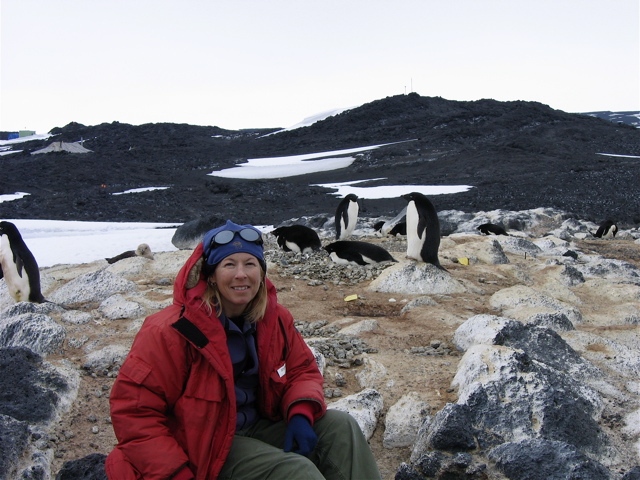 > Keeping an eye on things: 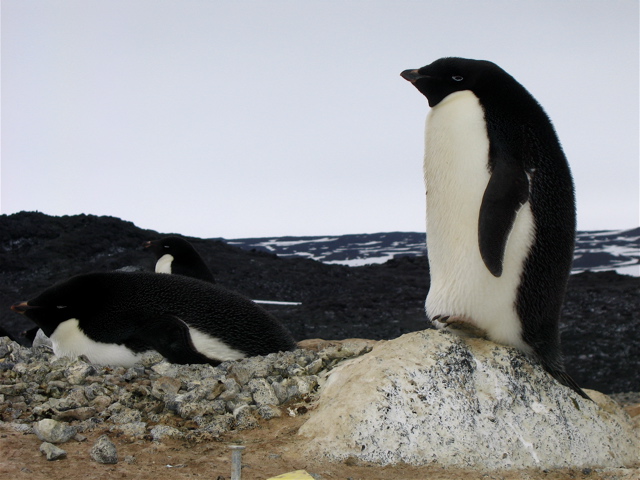 > Pair bonding:  > Two chicks are better than one! 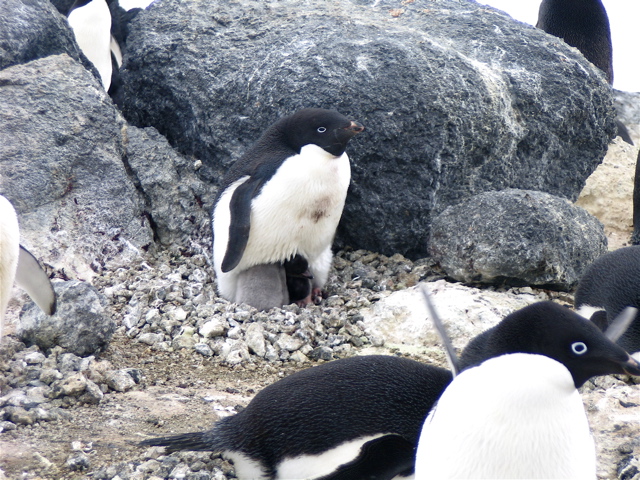 > Hello world! (Lisa calls this their "ET" phase because they look like ET) 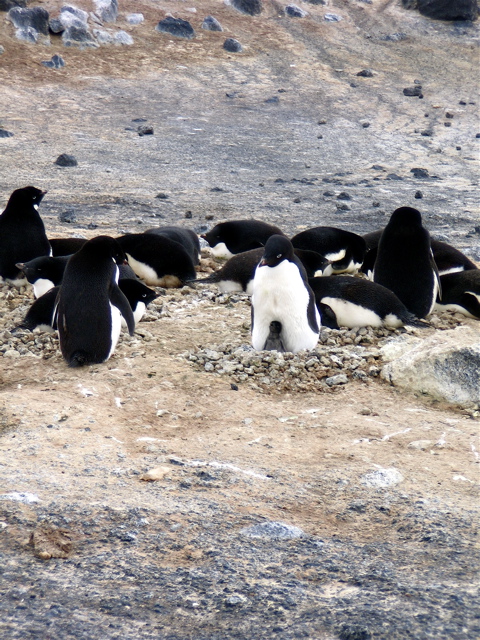 We soon met up with Dr. Ainley, and I asked him if he would explain his system for weighing the penguins. He said he had to go catch a bird to remove its GPS leg tag first, oh, and would I like to come along? Hmmm, decisions, decisions. Of course! > Dr. Ainley fixes a wing band:  > This GPS sensor tells Dr. Ainley where the birds go when they leave the rookery: 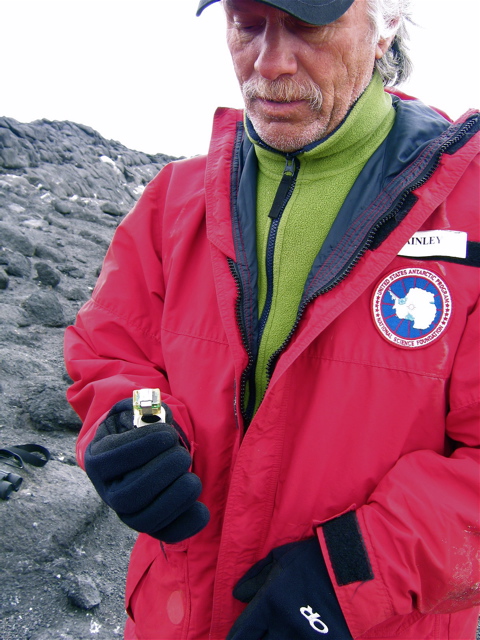 After removing the GPS leg tag from one bird and resetting the armband on another, we walked back to the “weight bridge” on the edge of the colony. To set up this area, he waited until the penguins inside had made their nests, then he put a small fence around them. The fence has one opening with a gate set into it, and this gate has a small scale that the penguins must cross to enter and exit their nesting site. Over the years, he has placed a small computer chip under the skins of many of these birds, and as they cross through the gate, sensors in the gate read the chip and determine which bird it is. He can then get accurate weight measurements over time. The females weigh about 2.8 kg and the males weigh about 3.2 kg. The whole thing is powered by a solar array and a computer kept inside a small tent next to the enclosure. You can see the tent and solar arrays in the photo above where I am talking with Lisa next to the enclosure. 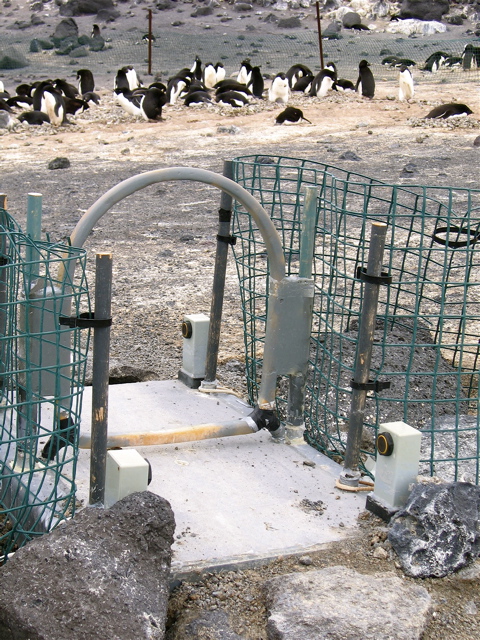 > A penguin crossing the weight gate:  They begin to lose weight at this time in their season because many of them have chicks to feed. They must walk about 60 kilometers (40 miles!) to the edge of the ice where they can dive into the open ocean to catch fish. They walk at a speed of about 2 km per hour and even slower as the sea ice that they must cross over becomes more and more rough. One of the parents makes this long walk and brings back food for the chick that they regurgitate to feed them, then the other parent makes the long walk next. > These guys are starting the long walk to the sea: 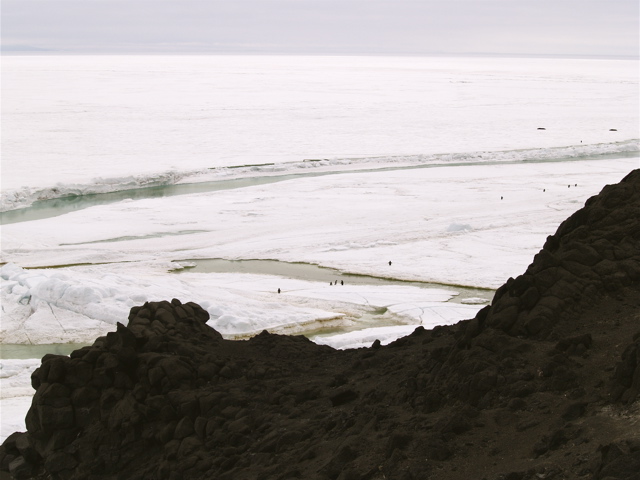 > Dangerous sea ice!  The skuas are also very busy right now, both raising their own chicks and stealing unguarded penguin chicks. Can you see the camouflaged skua chick?  > Our chariot has arrived to take us home: 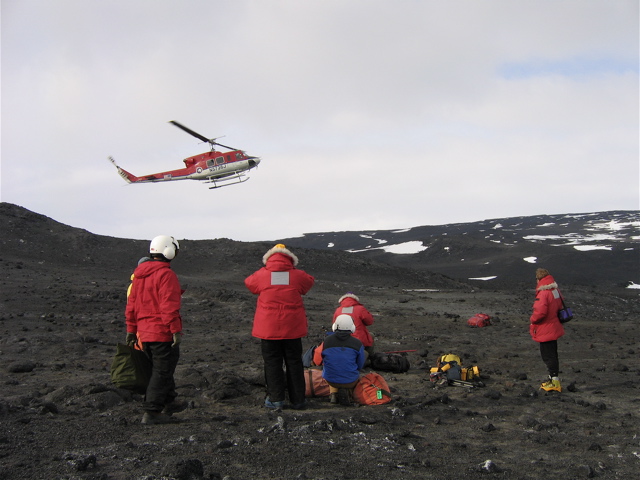 Did you know? Besides the “official” marathon run on the Antarctic Peninsula on the “tail” of the continent, McMurdo also has its own marathon on January 8th. One of the runners says it is like running a marathon in the sand, except that it is freezing. The runners and cross-country skiers will be running across the Ross Ice Shelf between the two airport that are used by McMurdo. The winning time in last year’s marathon was 4:14 by Lance Anderson, under strong wind conditions with blowing snow and ice. Water stations for the runners must be monitored to make sure they don’t blow away or freeze solid. Think about that, San Diego runners. Current Conditions at McMurdo Station Partly cloudy but nice and warm (above freezing!). A high >pressure system dominates the Ice Shelf. Right now: Variable light winds Pressure: 29.280 inHg Temperature: 34 oF/1 oC with wind chill: 28 F/ -2 C Sunset: February 20 at 1:38 am |
| Guest |
 Jan 2 2006, 03:20 AM Jan 2 2006, 03:20 AM
Post
#2
|
|
Unregistered |
hi Dena,
Your website continues to look great and is a nice way for me to keep up with what is happening now that I'm off of the Ice. I'm really glad that you were able to get out to Pony and talk with Dr. Ainley. Hopefully all goes smoothly this week. cheers-Christine |
| Gina Martin |
 Jan 3 2006, 12:33 AM Jan 3 2006, 12:33 AM
Post
#3
|
|
Unregistered |
HAPPY NEW YEAR, Dena!
What an extreme high you must have had to be able go on the helo + to be within the penguin rookery + to chat with the penguin experts! You go, girl! |
| Sarah |
 Jan 3 2006, 01:12 AM Jan 3 2006, 01:12 AM
Post
#4
|
|
Unregistered |
It sounds like you're having a blast there! The penguins are extremely cute and we're loving all the photos!
We can't wait for you to come back!!! See you soon! - Your 4th period TAs |
| megan Schilling |
 Jan 3 2006, 05:08 AM Jan 3 2006, 05:08 AM
Post
#5
|
|
Unregistered |
HELLO MS. R!!! dang it sounds like you are having a blast down there! you are so luckey to see all the pinguins and everything! im jelous.. i love all the pictures you've posted!
glad to hear you had a good holiday!!! cant wait untill you come back!!! -megan |
| Dena_Rosenberger |
 Jan 4 2006, 12:32 AM Jan 4 2006, 12:32 AM
Post
#6
|
 TREC Teacher    Group: TREC Team Posts: 96 Joined: 1-November 05 Member No.: 22 |
Hi Sarah and all of my other wonderful T.A.s!
Isn't this an amazing place! Thank you and all of my T.A.s who have helped sooooo much while I have been away from sunny Lakeside. I will see you all very soon! Love, Ms. R QUOTE(Sarah @ Jan 3 2006, 01:12 AM) |
| Dena_Rosenberger |
 Jan 4 2006, 12:35 AM Jan 4 2006, 12:35 AM
Post
#7
|
 TREC Teacher    Group: TREC Team Posts: 96 Joined: 1-November 05 Member No.: 22 |
Hi Megan! I AM having a blast! Stay tuned because this weekend I get to go LIVE with the penguins for a few days!
See you soon! Ms. R QUOTE(megan Schilling @ Jan 3 2006, 05:08 AM) |
| Megan Blakey |
 Jan 4 2006, 12:36 AM Jan 4 2006, 12:36 AM
Post
#8
|
|
Unregistered |
hey hey i bet youre sick of seeing penguins but i went to seaworld and i had to show you this funny fat one!
<img src="http://i17.photobucket.com/albums/b63/freddydood/seaworld131.jpg"> |
| Megan Blakey |
 Jan 4 2006, 12:37 AM Jan 4 2006, 12:37 AM
Post
#9
|
|
Unregistered |
hey hey i bet youre sick of seeing penguins but i went to seaworld and i had to show you this funny fat one!
 |
| Chris |
 Jan 5 2006, 12:47 AM Jan 5 2006, 12:47 AM
Post
#10
|
|
Unregistered |
For your amusement
|
| Guest |
 Jan 5 2006, 12:56 AM Jan 5 2006, 12:56 AM
Post
#11
|
|
Unregistered |
QUOTE(Dena_Rosenberger @ Jan 1 2006, 04:48 AM) Chicks on the Rocks December 31, 2005 For those interested in things Antarctic, check out the weekly Antarctic newspaper at http://AntarcticSun.usap.gov Hello from the Ice! For additional Antarctic pics, check out the Gallery. Thanks to all of my friends, family, and new acquaintances that wished me a Happy New Year! Where’s Rosenberger? Pony Lake, Ross Island, Antarctica So, in the last couple of days, our science group has made the decision to move operations back to Pony Lake to do the rest of our data collecting. Last week, I had written that they had decided to move to another lake since Pony Lake did not look like it would melt at all. This decision to return was made when it was seen that Pony Lake was actually melting, like it did last year, AND that the Dissolved Organic Matter (DOM) content was very high in the newly-melted water (Yippee! More penguin pictures!). With this decision, things have been very busy getting ready to set up a field camp there, since it will take about a week to pump enough water out of the lake and into 55-gallon drums to filter out the amount of DOM that they need for their experiments. > Chris reflects on the water:  > Penguins reflecting on the water:  Because of the Adelie penguin rookery, this area is an Antarctic Specially Managed Area (ASMA) and you must have special permits to even be there. We had to get extra-special permits to be able to put machinery there! Because the ASMA is very strict, we must put all of our equipment a certain distance away from the rookery because they do not allow anything to disturb the nesting birds. Yesterday, Chris and Yo had to go out to Pony Lake to take some GPS readings around the lake to decide where to place the pumps and generators, and since the sea ice is unstable now, they had to go by helicopter. They happened to have an extra seat on the helo, so guess who got to tag along? Yep, yours truly. What a rush! McMurdo from the air:  > The Barnes Glacier from above:  Since I didn’t really have any work to do, I wanted to photograph the penguins and see if there were any chicks since I hadn’t seen them for a month. We will be sharing Pony Lake with Dr. David Ainley, the foremost researcher on Adelie penguins in the world, and his intern Lisa Sheffield. I saw Lisa walking around in the rookery (where we are not allowed) and waited until she came down onto the lake to speak with her. She invited me to walk around with her, so in we went. Some of the penguins have two chicks, some have one, and some have none. Lisa said the birds with two chicks will probably lose one to either skuas or starvation. > Me (sitting) talking with Lisa Sheffield (standing):  > Hangin' with the birds:  > Keeping an eye on things:  > Pair bonding:  > Two chicks are better than one!  > Hello world! (Lisa calls this their "ET" phase because they look like ET)  We soon met up with Dr. Ainley, and I asked him if he would explain his system for weighing the penguins. He said he had to go catch a bird to remove its GPS leg tag first, oh, and would I like to come along? Hmmm, decisions, decisions. Of course! > Dr. Ainley fixes a wing band:  > This GPS sensor tells Dr. Ainley where the birds go when they leave the rookery:  After removing the GPS leg tag from one bird and resetting the armband on another, we walked back to the “weight bridge” on the edge of the colony. To set up this area, he waited until the penguins inside had made their nests, then he put a small fence around them. The fence has one opening with a gate set into it, and this gate has a small scale that the penguins must cross to enter and exit their nesting site. Over the years, he has placed a small computer chip under the skins of many of these birds, and as they cross through the gate, sensors in the gate read the chip and determine which bird it is. He can then get accurate weight measurements over time. The females weigh about 2.8 kg and the males weigh about 3.2 kg. The whole thing is powered by a solar array and a computer kept inside a small tent next to the enclosure. You can see the tent and solar arrays in the photo above where I am talking with Lisa next to the enclosure.  > A penguin crossing the weight gate:  They begin to lose weight at this time in their season because many of them have chicks to feed. They must walk about 60 kilometers (40 miles!) to the edge of the ice where they can dive into the open ocean to catch fish. They walk at a speed of about 2 km per hour and even slower as the sea ice that they must cross over becomes more and more rough. One of the parents makes this long walk and brings back food for the chick that they regurgitate to feed them, then the other parent makes the long walk next. > These guys are starting the long walk to the sea:  > Dangerous sea ice!  The skuas are also very busy right now, both raising their own chicks and stealing unguarded penguin chicks. Can you see the camouflaged skua chick?  > Our chariot has arrived to take us home:  Did you know? Besides the “official” marathon run on the Antarctic Peninsula on the “tail” of the continent, McMurdo also has its own marathon on January 8th. One of the runners says it is like running a marathon in the sand, except that it is freezing. The runners and cross-country skiers will be running across the Ross Ice Shelf between the two airport that are used by McMurdo. The winning time in last year’s marathon was 4:14 by Lance Anderson, under strong wind conditions with blowing snow and ice. Water stations for the runners must be monitored to make sure they don’t blow away or freeze solid. Think about that, San Diego runners. Current Conditions at McMurdo Station Partly cloudy but nice and warm (above freezing!). A high >pressure system dominates the Ice Shelf. Right now: Variable light winds Pressure: 29.280 inHg Temperature: 34 oF/1 oC with wind chill: 28 F/ -2 C Sunset: February 20 at 1:38 am |
| Louise Huffman |
 Jan 7 2006, 02:36 AM Jan 7 2006, 02:36 AM
Post
#12
|
|
Unregistered |
Hi Dena,
I'm really enjoying your journals--makes me wish I was back on the Ice with you! If you see David Ainley again, please tell him "hello" for me. I was actually assigned to work with him and then was changed at the last minute to the stream team in the Dry Valleys. Did get a chance to talk to him at McMurdo a couple of times. Love the penguin pics! Louise Huffman |
| Dena_Rosenberger |
 Jan 10 2006, 12:54 PM Jan 10 2006, 12:54 PM
Post
#13
|
 TREC Teacher    Group: TREC Team Posts: 96 Joined: 1-November 05 Member No.: 22 |
Hello Louise!
Your name has come up a fair number of times here in the last two months. Everyone from the Dry Valleys remembers you, and I've been hanging out with the helo pilots, too. I spoke with Dr. Ainley all the time when we were working out there, but my time here is coming to an end, so I probably won't see him again. So good to hear from you! Are you coming to NSTA? Take care, Dena QUOTE(Louise Huffman @ Jan 7 2006, 02:36 AM) Hi Dena, I'm really enjoying your journals--makes me wish I was back on the Ice with you! If you see David Ainley again, please tell him "hello" for me. I was actually assigned to work with him and then was changed at the last minute to the stream team in the Dry Valleys. Did get a chance to talk to him at McMurdo a couple of times. Love the penguin pics! Louise Huffman |
  |
1 User(s) are reading this topic (1 Guests and 0 Anonymous Users)
0 Members:

|
NSF Acknowledgment & Disclaimer | Time is now: 5th November 2024 - 06:45 AM |
Invision Power Board
v2.1.7 © 2024 IPS, Inc.









